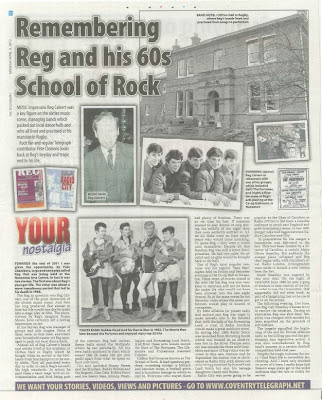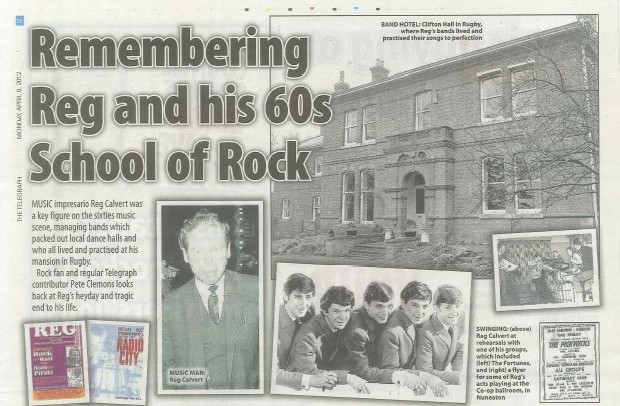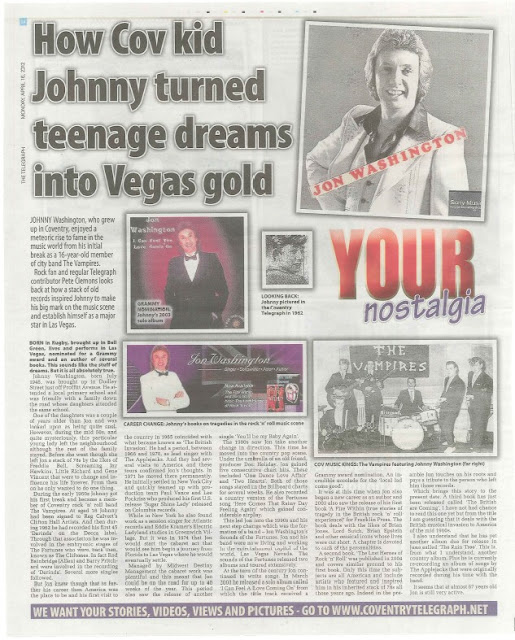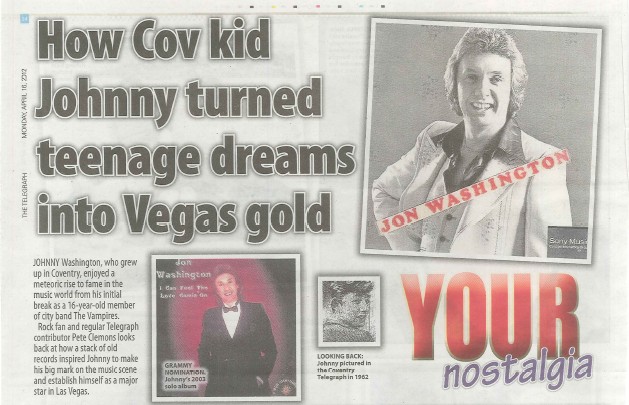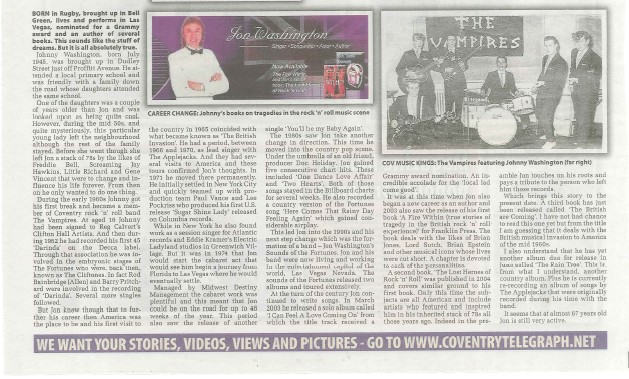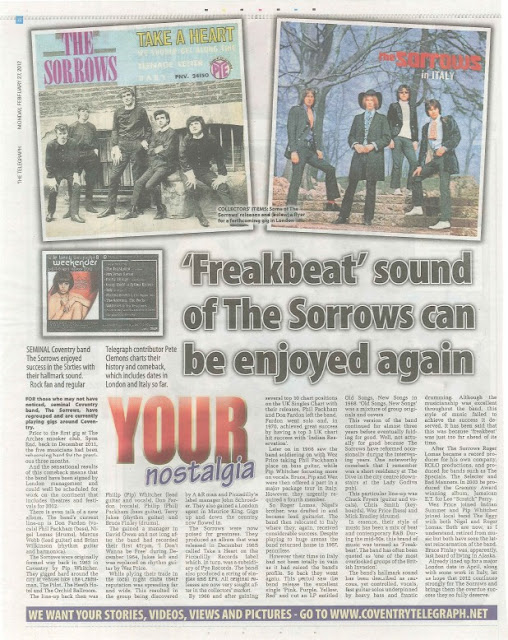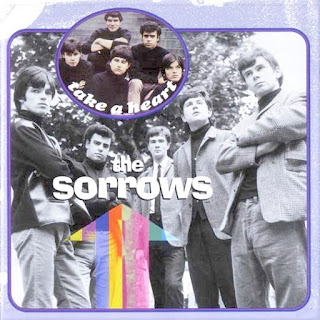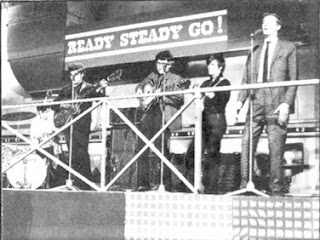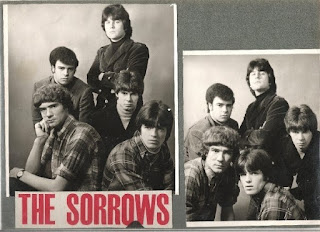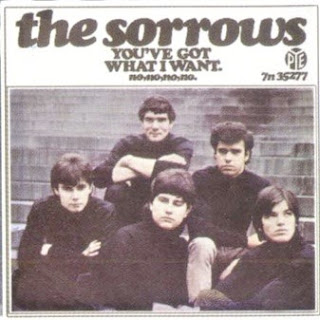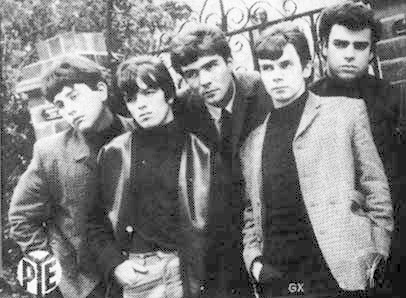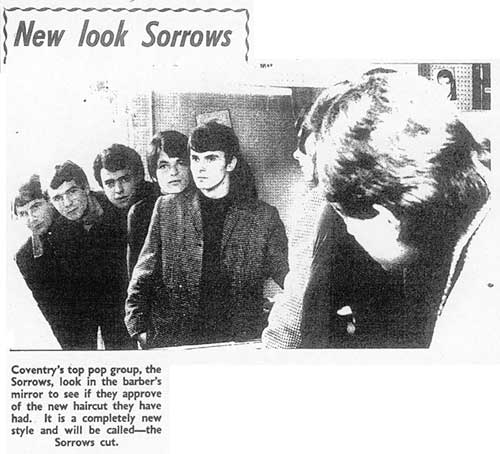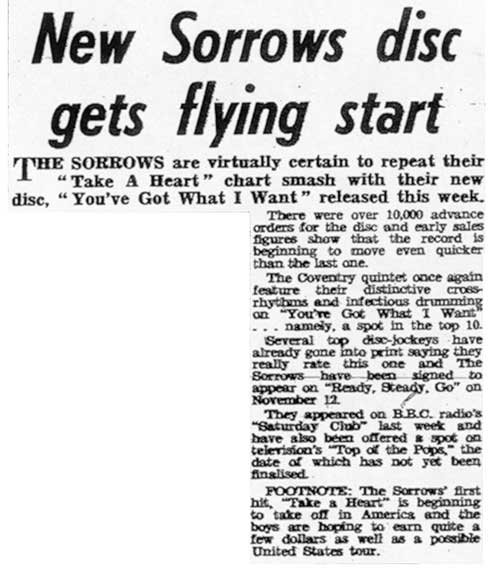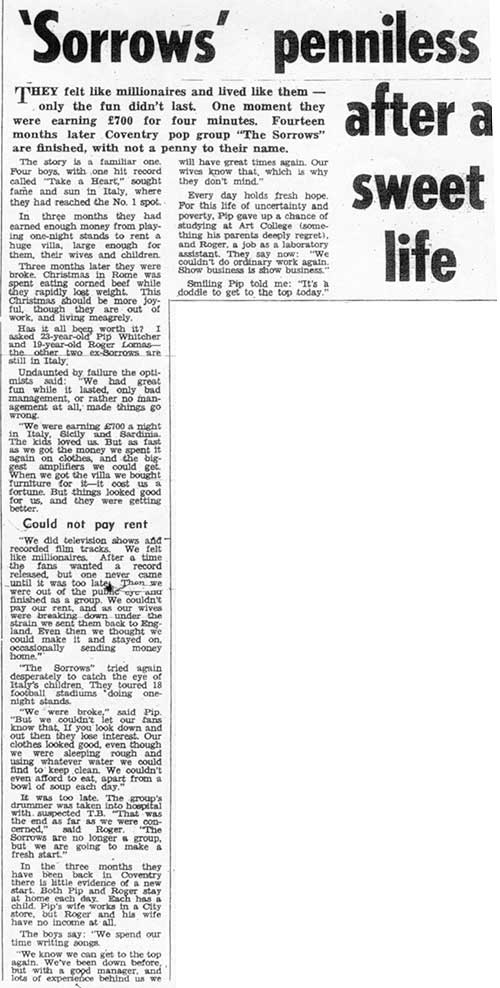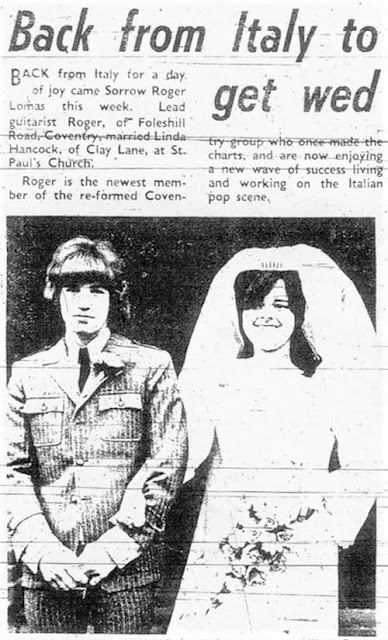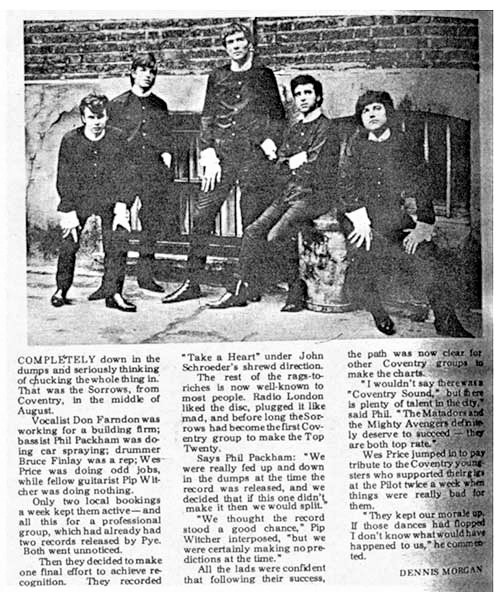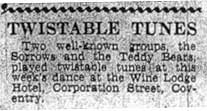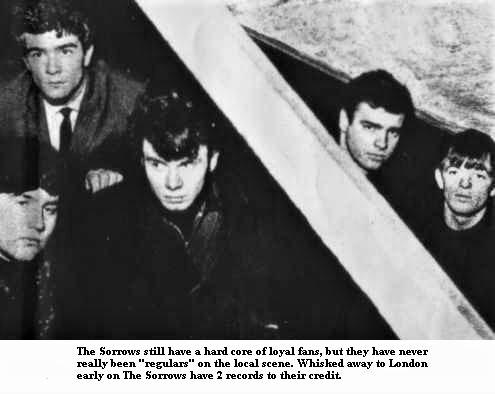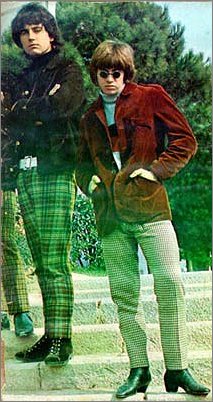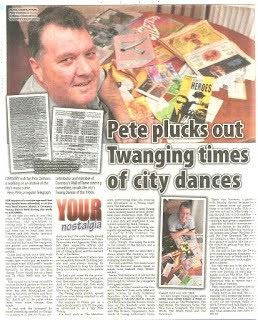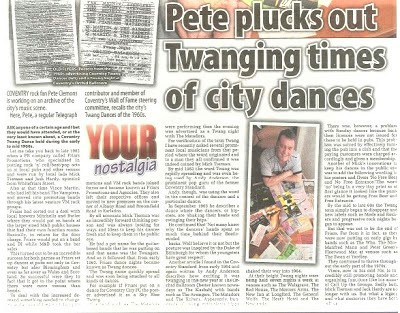Remembering Reg Calvert and his
60’s School of Rock
Article for the Coventry Telegraph.
And below that –
Johnny Washington
Remembering Reg and his 60s School of Rock; MUSIC impresario Reg Calvert was a key figure on the sixties music scene, managing bands which packed out local dance halls and who all lived and practiced at his mansion in Rugby. Rock fan and regular Telegraph contributor Pete Clemons looks back at Reg’s heyday and tragic end to his life. YOUR nostalgia.
TOWARDS the end of 2011 I was given the opportunity, by Pete Chambers, to go and see a play called Reg that was being held at the Nuneaton Arts Centre. In fact it was two stories. The first was about Reg’s younger life. The other was about a more tumultuous period that led to his death in 1966.
The Reg in question was Reg Calvert, one of the great characters of the sixties music scene. And Pete has long predicted that sooner or later his life would one day be made into a stage play or film. The plays, written by Reg’s daughter Susan Moore, have certainly left a lasting impression on me.
In his heyday Reg was manager of groups and solo singers. None of them were, at that time, anywhere near household names yet Reg managed to pack out local dance halls. Almost all of Reg Calvert’s bands and artists lived at his mansion in Clifton Hall in Rugby which he bought when he moved to the Midlands from Southampton in the early 1960s. They all practised every day in order to reach Reg’s incredible high standards. In return he paid them a basic wage with all accommodation and food being part of the contract. Reg had various dance halls round the Midlands which he ran personally. All his own bands appeared in them which meant that he made 100 per cent profit apart from what he spent on food and travel.
His acts included Danny Storm and the Strollers, Buddy Britten and the Regents, Glen Dale, Robbie Hood and his Merry Men, Johnny Washington and Screaming Lord Sutch. And from these acts would morph the likes of The Fortunes, The Liberators and Pinkertons Assorted Colours.
He had two rules. No alcohol and no girls would be brought back to the hall.
One of Reg’s most popular ventures was his regular ‘Teen Beat’ nights held on Friday and Saturday evenings at the Co-op Hall in Nuneaton.
These were, of course, aimed at the over 18s but Reg was also very keen to entertain and not let down the under 18s who would not have been allowed into the late night dances. So at the same venue he ran Saturday clubs where the same performers would play to hoards of youngsters.
By 1964 offshore (or pirate) radio had arrived and Reg was eager to make inroads into it. He decided that, with the help of the Screaming Lord, a rival to Radio Caroline would make a great publicity stunt. So during May 1964 Radio Sutch was launched from Shivering Sands which was located on an observation fort in the River Thames estuary just outside the three mile limit. More and more of Reg’s time was devoted to this new venture and by September the station was re christened as Radio City with shows not only being presented by himself and Lord Sutch but also his teenage daughters Candy and Susan.
Radio City was never going to be popular as the likes of Caroline or Radio 270 but it did have a sizeable audience in south east England and grew in monetary terms. In late 1965 merger talks had began between Radio’s Caroline and City.
In preparation for the merger a transmitter was delivered to the fort. This had been funded by a director of Caroline, a certain Major Oliver Smedley. But suddenly the merger plans collapsed and Reg then began talks with Caroline’s rival, Radio London. Arrangements were made to launch a new station from the fort.
Major Smedley was angered by this new deal. On the night of 19th/20th June 1966 he sent a gang of dockers to take control of the fort in order to use the transmitter, that apparently did not even work, as part of a bargaining tool so he could get in on the action.
The following evening, 21st June, saw Reg visit Smedley’s house to try to resolve the situation. During an altercation Reg was shot dead. Smedley was charged with murder but later acquitted on the grounds of self defence.
The tragedy signalled the beginning of the end for British offshore radio as the killing spurred the government into legislative action. It was also overshadowed by England’s success in a certain football competition held that year.
Despite the tragic outcome the story I find Reg’s life is incredibly fascinating.
And I have only touched on parts of it here. I really hope that Susan’s stage plays get to the wider audience that the tale so richly deserves.
…………………………………………………..
NEW 2018 – Pete Clemons reviews the new trilogy on Reg Calvert –
LIFE AND DEATH OF A PIRATE by S.K. Moore.
BORN in Rugby, brought up in Bell Green, lives and performs in Las Vegas, nominated for a Grammy award and an author of several books. This sounds like the stuff of dreams. But it is all absolutely true. Johnny Washington, born July 1945, was brought up in Dudley Street just off Proffitt Avenue. He attended a local primary school and was friendly with a family down the road whose daughters attended the same school. One of the daughters was a couple of years older than Jon and was looked upon as being quite cool. However, during the mid 50s, and quite mysteriously, this particular young lady left the neighbourhood although the rest of the family stayed. Before she went though she left Jon a stack of 78s by the likes of Freddie Bell, Screaming Jay Hawkins,
Little Richard and Gene Vincent that were to change and influence his life forever. From then on he only wanted to do one thing. During the early 1960s Johnny got his first break and became a member of Coventry rock ‘n’ roll band The Vampires. At aged 16 Johnny had been signed to Reg Calvert’s Clifton Hall Artists. And then during 1962 he had recorded his first 45 ‘Darinda’ on the Decca label. Through that association he was involved in the embryonic stages of The Fortunes who were, back then, known as The Cliftones. In fact Rod Bainbridge (Allen) and Barry Pritchard were involved in the recording of ‘Darinda’. Several more singles followed. But Jon knew though that to further his career then America was the place to be and his first visit to the country in 1965 coincided with what became known as ‘The British Invasion’. He had a period, between 1966 and 1970, as lead singer with The Applejacks. And they had several visits to America and these tours confirmed Jon’s thoughts. In 1971 he moved there permanently. He initially settled in New York City and quickly teamed up with production team Paul Vance and Lee Pockriss who produced his first U.S. release ‘Sugar Shine Lady’ released on Columbia records. While in New York he also found work as a session singer for Atlantic records and Eddie Kramer’s Electric Ladyland studios in Greenwich Village. But it was in 1974 that Jon would start the cabaret act that would see him begin a journey from Florida to Las Vegas where he would eventually settle. Managed by Midwest Destiny Management the cabaret work was plentiful and this meant that Jon could be on the road for up to 48 weeks of the year. This period also saw the release of another single ‘You’ll be my Baby Again’. The 1980s saw Jon take another change in direction.
This time he moved into the country pop scene. Under the umbrella of an old friend, producer Doc Holiday, Jon gained five consecutive chart hits. These included ‘One Dance Love Affair’ and ‘Two Hearts’. Both of those songs stayed in the Billboard charts for several weeks. He also recorded a country version of the Fortunes song ‘Here Comes That Rainy Day Feeling Again’ which gained considerable airplay. This led Jon into the 1990s and his next step change which was the formation of a band – Jon Washington’s Sounds of the Fortunes. Jon and his band were now living and working in the entertainment capitol of the world, Las Vegas Nevada. The sounds of the Fortunes released two albums and toured extensively. At the turn of the century Jon continued to write songs. In March 2003 he released a solo album called ‘I Can Feel A Love Coming On’ from which the title track received a Grammy award nomination. An incredible accolade for the ‘local lad come good’. It was at this time when Jon also began a new career as an author and 2003 also saw the release of his first book ‘A Fire Within (true stories of tragedy in the British rock ‘n’ roll experience)’ for Franklin Press. The book deals with the likes of Brian Jones, Lord Sutch, Brian Epstein and other musical icons whose lives were cut short. A chapter is devoted to each of the personalities. A second book, ‘The Lost Heroes of Rock ‘n’ Roll’ was published in 2004 and covers similar ground to his first book. Only this time the subjects are all American and include artists who featured and inspired him in his inherited stack of 78s all those years ago. Indeed in the preamble Jon touches on his roots and pays a tribute to the person who left him those records. Which brings this story to the present date. A third book has just been released called ‘The British are Coming’. I have not had chance to read this one yet but from the title I am guessing that it deals with the British musical invasion to America of the mid 1960s. I also understand that he has yet another album due for release in June called ‘The Rain Tree’. This is, from what I understand, another country album. Plus he is currently re-recording an album of songs by The Applejacks that were originally recorded during his time with the band. It seems that at almost 67 years old Jon is still very active.

